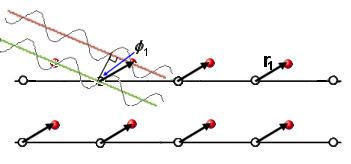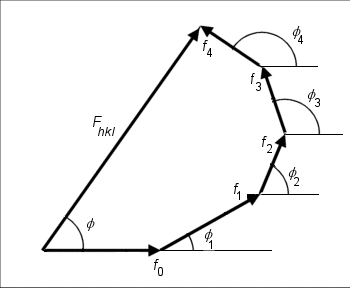Difference between revisions of "Structure factor"
From Online Dictionary of Crystallography
AndreAuthier (talk | contribs) |
BrianMcMahon (talk | contribs) |
||
| Line 19: | Line 19: | ||
The intensity of a diffracted beam is directly related to the amplitude of the structure factor, but the phase must normally be deduced by indirect means. In [[structure determination]], phases are estimated and an initial description of the positions and anisotropic displacements of the scattering atoms is deduced. From this initial model, structure factors are calculated and compared with those experimentally observed. Iterative [[refinement]] procedures attempt to minimise the difference between calculation and experiment, until a satisfactory fit has been obtained. | The intensity of a diffracted beam is directly related to the amplitude of the structure factor, but the phase must normally be deduced by indirect means. In [[structure determination]], phases are estimated and an initial description of the positions and anisotropic displacements of the scattering atoms is deduced. From this initial model, structure factors are calculated and compared with those experimentally observed. Iterative [[refinement]] procedures attempt to minimise the difference between calculation and experiment, until a satisfactory fit has been obtained. | ||
| + | |||
| + | == Derivation == | ||
| + | |||
| + | [[Image:sfac1.gif|frame|Figure 1|right]] | ||
| + | |||
| + | Consider Fig. 1, which illustrates [[Bragg's law]] for an array of atom scatterers in a primitive lattice with just one atom at each lattice point. An incident X-ray wave of wavelength <math>\lambda</math> diffracts strongly through an angle <math>2\theta</math> where the perpendicular distance between two lattice planes <math>d_{hkl}</math> satisfies the relation | ||
| + | |||
| + | <math>2d_{hkl}\sin \theta = n\lambda</math>. | ||
| + | |||
| + | It is seen that the path difference between waves diffracted from the two planes shown differs by just one wave cycle. | ||
| + | |||
| + | [[Image:sfac2.gif|frame|Figure 2|right]] | ||
| + | |||
| + | Now consider Fig. 2, where a second atom (drawn in red) is added to the unit cell. Each original atom is now accompanied by a companion atom of the new type, offset by a displacement vector '''r'''<sub>1</sub>. The incident X-ray beam will also diffract from these new scatterers (since they occupy planes parallel to those originally drawn). But now there is a phase difference <math>\phi_1</math> between the waves scattered from the first and the new sets of atoms. | ||
| + | |||
| + | [[Image:sfac3.gif|frame|Figure 3|right]] | ||
| + | |||
| + | Figure 3 is a vector diagram illustrating the resultant wave scattered from the two sets of atoms. The amplitudes of the waves are proportional to the atomic scattering factors ''f''<sub>0</sub> and ''f''<sub>1</sub>. The phases differ by the angle <math>\phi_1</math> (see Fig. 2). The resultant vector represents the two-atom structure factor with amplitude <math>F_{hkl}</math>. Note that there is a net phase <math>\phi</math> arising from the phase difference due to the offset in position between the two sets of diffracting atoms. | ||
| + | |||
| + | |||
| + | [[Image:sfac4.gif|frame|Figure 4|right]] | ||
| + | |||
| + | Figure 4 generalises this result for a unit cell containing several more atoms. As in the case of two atoms, the resultant diffracted wave is obtained from the linear superposition of the wave vectors scattered from each different atom. | ||
== Units == | == Units == | ||
Revision as of 15:30, 1 April 2008
Facteur de structure atomique (Fr).
Contents
Definition
The structure factor [math]\mathbf{F}_{hkl}[/math] is a mathematical function describing the amplitude and phase of a wave diffracted from crystal lattice planes characterised by Miller indices [math]h, k, l[/math].
The structure factor may be expressed as
[math]\mathbf{F}_{hkl} = F_{hkl}\exp(i\alpha_{hkl}) = \sum_j f_j\exp[2\pi i (hx_j + ky_j + lz_j)] [/math]
[math]\qquad = \sum_j f_j\cos[2\pi (hx_j + ky_j + lz_j)] + i\sum_{j} f_j\sin[2\pi (hx_j + ky_j + lz_j)][/math]
[math]\qquad = A_{hkl} + iB_{hkl}[/math]
where the sum is over all atoms in the unit cell, [math]x_j, y_j, z_j[/math] are the positional coordinates of the [math]j[/math]th atom, [math]f_j[/math] is the scattering factor of the [math]j[/math]th atom, and [math]\alpha_{hkl}[/math] is the phase of the diffracted beam.
The intensity of a diffracted beam is directly related to the amplitude of the structure factor, but the phase must normally be deduced by indirect means. In structure determination, phases are estimated and an initial description of the positions and anisotropic displacements of the scattering atoms is deduced. From this initial model, structure factors are calculated and compared with those experimentally observed. Iterative refinement procedures attempt to minimise the difference between calculation and experiment, until a satisfactory fit has been obtained.
Derivation
Consider Fig. 1, which illustrates Bragg's law for an array of atom scatterers in a primitive lattice with just one atom at each lattice point. An incident X-ray wave of wavelength [math]\lambda[/math] diffracts strongly through an angle [math]2\theta[/math] where the perpendicular distance between two lattice planes [math]d_{hkl}[/math] satisfies the relation
[math]2d_{hkl}\sin \theta = n\lambda[/math].
It is seen that the path difference between waves diffracted from the two planes shown differs by just one wave cycle.
Now consider Fig. 2, where a second atom (drawn in red) is added to the unit cell. Each original atom is now accompanied by a companion atom of the new type, offset by a displacement vector r1. The incident X-ray beam will also diffract from these new scatterers (since they occupy planes parallel to those originally drawn). But now there is a phase difference [math]\phi_1[/math] between the waves scattered from the first and the new sets of atoms.
Figure 3 is a vector diagram illustrating the resultant wave scattered from the two sets of atoms. The amplitudes of the waves are proportional to the atomic scattering factors f0 and f1. The phases differ by the angle [math]\phi_1[/math] (see Fig. 2). The resultant vector represents the two-atom structure factor with amplitude [math]F_{hkl}[/math]. Note that there is a net phase [math]\phi[/math] arising from the phase difference due to the offset in position between the two sets of diffracting atoms.
Figure 4 generalises this result for a unit cell containing several more atoms. As in the case of two atoms, the resultant diffracted wave is obtained from the linear superposition of the wave vectors scattered from each different atom.
Units
The units of the structure-factor amplitude depend on the incident radiation. For X-ray crystallography they are multiples of the unit of scattering by a single electron ([math]2.82 \times 10^{-15}[/math] m); for neutron scattering by atomic nuclei the unit of scattering length of [math]10^{-14}[/math] m is commonly used.
See also
Introduction to the Calculation of Structure Factors, teaching pamphlet No. 3 of the International Union of Crystallography
The structure factor. P. Coppens. International Tables for Crystallography (2006). Vol. B, ch. 1.2, pp. 10-24 doi:10.1107/97809553602060000550



